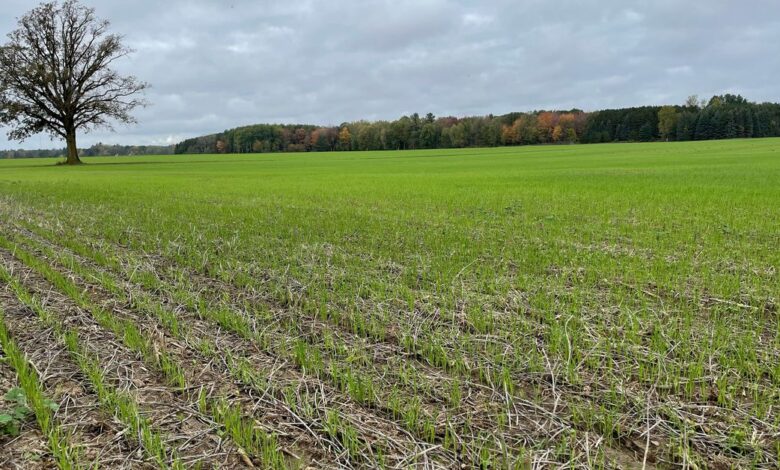Dollars in the dirt: Big Ag pays farmers for control of their soil-bound carbon

A canopy crop of winter purple wheat is seen at Peter Maxwell Farms in Beaverton, Michigan, U.S., on this undated handout image. Bayer AG/Handout by way of REUTERS
WINNIPEG, Manitoba/CHICAGO, Oct 25 (Reuters) – The most important world agriculture firms are competing on a brand new entrance: attractive farmers to hitch applications that preserve atmosphere-warming carbon dioxide within the soil.
Fertilizer producers Nutrien Ltd and Yara , agribusiness big Cargill Inc (CARG.UL), and seed and chemical sellers Corteva Inc and Bayer AG are paying growers for each acre of land devoted to trapping carbon underground, often called sequestering it. The businesses’ ambitions stretch from the USA to Canada, Brazil, Europe and India, executives instructed Reuters.
Farmers seize carbon by planting low season crops, tilling the bottom much less and utilizing fertilizer extra effectively. They log their practices on digital platforms to generate a carbon credit score. Agricultural firms use the credit to offset the local weather impression of different elements of their companies or promote them to firms trying to scale back their very own carbon footprints.
Agriculture covers practically 40% of the world’s land and is liable for 17% of world emissions, in line with the United Nations. Adjustments to farm practices might sequester as a lot as 250 million tonnes of carbon dioxide yearly in the USA, or 4% of the nation’s emissions, in line with a by the Nationwide Academy of Sciences.
Agriculture is subsequently more and more seen as a possible ally as firms and governments try to satisfy decrease greenhouse fuel emission targets and battle world warming.
Some farmers view the applications run by the enormous agricultural firms with suspicion – as a way to reap their knowledge that will likely be used to promote them extra merchandise, in line with interviews with greater than a dozen farmers, analysts and farm teams. Different critics query whether or not it’s even attainable for farmers to ensure they’re holding carbon underground as a result of merely turning the soil can undo efforts to retailer it.
Sequestering carbon, nevertheless, can present a brand new income stream for farmers trying to diversify in a risky business. The farming strategies required by such applications provide the extra promise of realizing increased yields from more healthy soils which can be much less reliant on chemical compounds.
Hoping to be rewarded for decreasing tillage and planting a canopy crop on his central Illinois farm, Matt Tracy enrolled 548 acres in Cargill’s RegenConnect program, selecting it over the same one supplied by Bayer on account of its brief, single-season contract time period.
He stays completely happy along with his choice even after Bayer, whose program requires a 10-year dedication, started providing sign-up bonuses of as much as $1,000.
“I did not need to be tied up for too a few years in a contract … I need to see the way it goes earlier than I bounce in whole-hog,” he mentioned. “I feel these applications might change into increasingly well-liked and we will receives a commission greater than we at the moment are.”
Agriculture firms can measure success by the variety of acres farmers dedicate to their applications and commitments from different firms to ultimately purchase the credit generated, mentioned Alejandro Plastina, affiliate professor in economics at Iowa State College. Many of the company commitments are imprecise, nevertheless, and the acres in pilot initiatives stay small, he mentioned.
For little price, agriculture firms get to showcase their social accountability, whereas securing farmers’ loyalty to their digital platforms that may flip into larger farm provide gross sales down the street, Plastina mentioned.
“It offers (ag firms) the chance to affiliate their manufacturers with caring for the world,” Plastina mentioned. “I do not count on them to become profitable on these initiatives anytime quickly.”
EARLY LEADERS
Bayer is an early chief with round 1.5 million acres enrolled in sustainable agriculture applications globally, principally in the USA.
Bayer’s program is exclusive in that it compensates growers for planting cowl crops and decreasing tillage, quite than paying them for what number of tonnes of verified carbon they sequester.
“The concept was to get one thing that farmers really feel comfy with and sure of to allow them to have a line of sight by way of how a lot cash they will make,” mentioned Leo Bastos, head of Bayer’s carbon enterprise.
Nutrien’s program has secured 200,000 acres in the USA and Canada this 12 months. Nutrien expects to make a revenue from the beginning, as a result of enrolment includes promoting farmers high-margin merchandise like crop therapies composed of insect-killing micro organism or controlled-release fertilizer, mentioned Mark Thompson, the corporate’s Chief Technique and Sustainability officer.
Such merchandise additionally generate increased yields for farmers, Thompson mentioned.
Cargill goals to scale back its supply-chain emissions 30% by 2030 partly by enrolling 10 million acres in small-scale regenerative agriculture applications.
Corteva’s partnership with farm expertise and companies supplier Indigo Ag rewards farmers for higher crop nutrient administration, which might encourage purchases of merchandise resembling nitrogen stabilizers, which make extra environment friendly use of fertilizer.
“Corteva sees that as a approach to deepen their relationship” with farmers, mentioned Chris Harbourt, Indigo’s world head of carbon.
Norway-based Yara is operating a pilot program on 50,000 U.S. acres and plans to have 1 million U.S. acres underneath contract by year-end.
Brazil and India, the place farmers harvest a number of crops annually, might generate bigger volumes of sequestered carbon than the USA underneath Yara’s program in as little as three years, mentioned Alex Bell, chief govt of this system, referred to as Agoro Carbon Alliance.
Agoro has an edge over some rivals as a result of it’s signing farmers to longer contracts, ten years, that ought to yield increased costs for his or her carbon, Bell mentioned.
“It is a powerful factor to ask of farmers, however that is what (credit score) consumers truly worth,” Bell mentioned. With the common U.S. farmer nearing retirement age, some are reluctant to lock in long-term, he mentioned.
Yara is launching its program at a loss and will break even inside three years, Bell mentioned.
Farmers, nevertheless, give the applications blended critiques.
“I scent full bullshit – it is a horrible thought,” mentioned Manitoba farmer Gunter Jochum, president of the Western Canadian Wheat Growers Affiliation. In return for small funds to farmers, ag firms acquire entry to useful knowledge, he mentioned.
The applications’ precept is “primarily unworkable,” as a result of carbon sequestration is just not everlasting, particularly in a warming local weather, Canada’s Nationwide Farmers Union mentioned in a submission to the Canadian authorities.
However North Dakota farmer Justin Topp determined to offer carbon farming a strive. He dedicated 12,000 acres, or 80% of his land to Nutrien’s program, selecting it over 4 others.
“Everyone’s speaking about it. I am interested in what shakes out.”
Reporting by Rod Nickel in Winnipeg and Karl Plume in Chicago
Enhancing by Caroline Stauffer and Matthew Lewis
:





